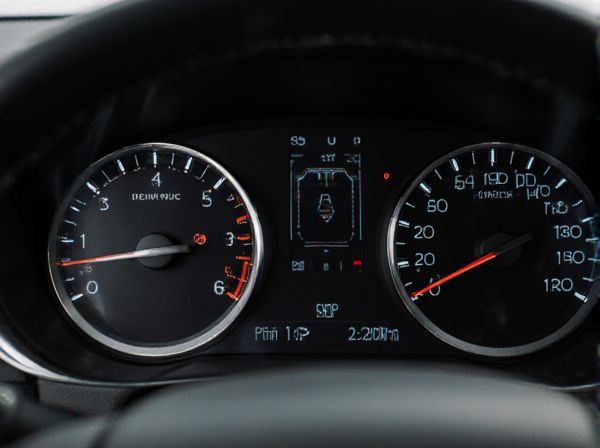
Photo illustration: Bar-Type Fuel Gauge vs Sweep Needle Fuel Gauge
Bar-type fuel gauges provide a clear, segmented display that allows you to easily track fuel levels at a glance, offering precise increments of measurement. Sweep needle fuel gauges use a moving needle to indicate fuel level on a circular dial, giving a more traditional and analog reading that some users find intuitive. Choosing the right gauge depends on your preference for either a modern, digital-like display or a classic, continuous visual indicator.
Table of Comparison
| Feature | Bar-Type Fuel Gauge | Sweep Needle Fuel Gauge |
|---|---|---|
| Display Type | Horizontal/Vertical LED or LCD bars | Analog needle sweeping across dial |
| Readability | Clear, immediate fuel level visualization | Traditional, intuitive dial reading |
| Precision | Segmented, less precise increments | Continuous, more precise fuel level indication |
| Design Aesthetics | Modern, digital look | Classic, analog style |
| Durability | Less mechanical parts, higher durability | Mechanical needle prone to wear |
| Response Time | Instant update on fuel changes | Smooth needle movement may delay updates |
| Power Consumption | Higher due to LEDs or LCDs | Lower, primarily mechanical |
| Cost | Moderate, depends on display tech | Generally lower cost |
Introduction to Fuel Gauge Types
Bar-type fuel gauges use a series of illuminated segments to represent fuel levels, providing a clear and easy-to-read visual indication. Sweep needle fuel gauges employ a moving needle that sweeps across a dial to show the current fuel amount, offering precise analog measurement. Both types rely on sensors in the fuel tank and provide essential feedback to drivers for fuel management.
Overview of Bar-Type Fuel Gauges
Bar-type fuel gauges use a series of LED or LCD segments that illuminate progressively to indicate fuel level, offering precise, easily readable information at a glance. These gauges provide rapid response and enhanced visibility compared to sweep needle gauges, making them ideal for modern digital dashboards. Their segmented design reduces ambiguity in fuel readings, improving driver awareness and fuel management efficiency.
Overview of Sweep Needle Fuel Gauges
Sweep needle fuel gauges feature a single needle that moves smoothly across a calibrated arc to indicate fuel level, providing a precise and easily readable display. Unlike bar-type fuel gauges that use segmented LED or LCD bars to show fuel status, sweep needle gauges rely on an analog mechanism driven by a sender unit in the fuel tank. This classic design offers continuous variable feedback, making it highly effective for real-time fuel level monitoring in cars, motorcycles, and other vehicles.
Visual Clarity and Readability Comparison
Bar-type fuel gauges offer clear, segmented displays that allow drivers to quickly assess fuel levels at a glance, enhancing visual clarity especially in low-light conditions. Sweep needle fuel gauges provide a continuous, analog-style reading that can give a more precise indication of fuel quantity but may be harder to interpret rapidly under dynamic driving situations. The bar-type gauge's discrete segments improve readability by minimizing ambiguity, whereas the sweep needle's fluid motion delivers a detailed but less immediately accessible fuel status.
Accuracy and Precision in Fuel Measurement
Bar-type fuel gauges provide a segmented, easy-to-read display that offers consistent accuracy by indicating fuel levels in discrete steps, reducing the risk of misinterpretation during rapid fuel consumption changes. Sweep needle fuel gauges offer continuous, fine-grained readings with smoother needle movement, allowing for more precise monitoring of fuel levels but may be susceptible to slight fluctuations or vibrations affecting needle stability. When prioritizing accuracy and precision, bar-type gauges excel in clear, reliable segment updates, while sweep needle gauges offer detailed real-time insights, making the choice dependent on user preference for discrete versus continuous fuel measurement feedback.
User Experience and Preferences
Bar-type fuel gauges provide a clear, progressive visual representation of fuel levels, enhancing quick readability and reducing the risk of misinterpretation during driving. Sweep needle fuel gauges offer a traditional analog feel, allowing users who prefer classic instrumentation to monitor fuel with a familiar dial movement. User preference often depends on individual comfort with digital clarity versus analog aesthetics, with many drivers favoring bar-type for straightforward accuracy and sweep needle for visual nostalgia.
Technological Advancements and Integration
Bar-type fuel gauges utilize LED segments to display fuel levels, offering precise and quick readability through digital technology, while sweep needle gauges rely on analog servo motors that provide a traditional, continuous pointer movement. Advances in microprocessor integration have enabled bar-type gauges to incorporate real-time diagnostics and customizable display patterns, enhancing vehicle interface and driver awareness. Modern vehicles increasingly adopt bar-type systems due to their ability to integrate with digital dashboards and telematics, improving overall fuel management accuracy and user experience.
Cost and Maintenance Considerations
Bar-type fuel gauges generally cost more upfront due to their digital display components and require less frequent maintenance because they have fewer moving parts. Sweep needle fuel gauges feature an analog needle mechanism that is typically less expensive but may require more regular calibration and maintenance to ensure accuracy. Cost-effectiveness depends on usage conditions, with bar-type gauges favored for low-maintenance benefits and sweep needle gauges preferred for budget-conscious applications.
Application in Modern Vehicles
Bar-type fuel gauges provide clear, incremental fuel level readings ideal for electric and hybrid vehicles requiring precise energy monitoring. Sweep needle fuel gauges offer a traditional analog display favored in classic cars and motorcycles, delivering intuitive, real-time fuel status. Modern vehicles increasingly adopt bar-type gauges for enhanced accuracy and integration with digital dashboards and telematics systems.
Conclusion: Choosing the Right Fuel Gauge
Selecting the right fuel gauge depends on your preference for readability and design; bar-type fuel gauges offer a clear, segmented display ideal for quickly assessing fuel levels at a glance. Sweep needle fuel gauges provide a classic, analog style favored for its smooth motion and traditional look, often preferred in vintage or high-end vehicles. Consider your vehicle's dashboard aesthetic and how you prioritize precision versus style to determine the most suitable option.
 caratoz.com
caratoz.com